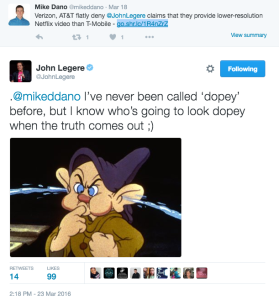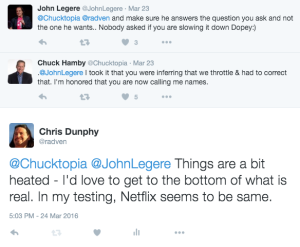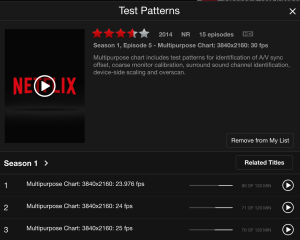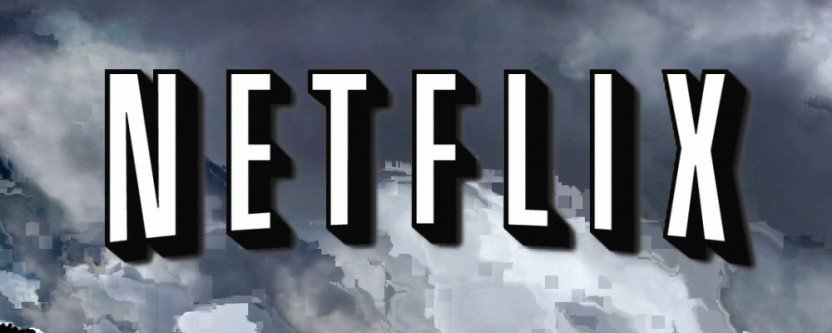Last week when T-Mobile announced that YouTube had joined Binge On, CEO John Legere boasted in his video announcing the news that:
"Here's a little factoid for you: Did you know that when you watch Netflix on T-Mobile, you get it at 480p. And the duopoly (Verizon and AT&T) is actually delivering your Netflix content at 360p. I bet you didn't know that. Go check, it's true."

AT&T and Verizon were quick to deny the claims, telling Fierce Wireless:
"Playback over LTE varies on network speeds, and we don't set a speed," Verizon's Chuck Hamby said, adding that factors such as weather and coverage can affect video resolution. "It's just a dopey claim and has no basis in fact at all."
AT&T echoed Hamby's thoughts. "Once again, T-Mobile is not giving you the complete facts," the operator said via email. "We do not reduce the resolution of any video on our network -- in fact, our customers on 4G LTE can get much higher resolution than T-Mobile's optimized 480p limit."
Our own testing however showed that both sides were wrong.
We tested Netflix streaming on AT&T, Verizon, and T-Mobile with an iPad and saw the same 512x384 resolution 560kbps stream on all three.
But switching from direct cellular to connecting via a mobile hotspot, using Wi-Fi on the iPad allowed for glorious 1080p streaming on all three carriers (or a 1500kbps 480p with T-Mobile's Binge On turned).
In the past however - we have seen higher cellular streaming resolutions on T-Mobile and AT&T.
It seemed like if anything was going on - the Netflix app was responsible.
Today, Netflix admitted to the Wall Street Journal that it is indeed throttling video over cellular connections.
And it has been doing it for the past five years.
Table of Contents
Netflix Throttles to “Protect” You

Netflix explained to the WSJ that it automatically caps video streams to a max speed of 600kpbs (which works out to a typical 512x384 resolution) for most carriers around the world to "protect consumers from exceeding mobile data caps" - and in the USA this includes streaming to Verizon and AT&T.
Netflix said that T-Mobile and Sprint are currently exempt from automatic throttling because of "more consumer-friendly policies" that slow customer speeds rather than charging overages when the monthly data limits are exceeded.
But in our testing this week this behavior has been inconsistent - and we have definitely seen Netflix limit itself to 384p resolution on T-Mobile too.
Netflix blogged last night that the upcoming "Mobile Data Saver" feature will give customers direct control over how much data they are using:
The data saver feature will provide members with more control over their data usage when streaming on mobile networks, allowing them to either stream more video under a smaller data plan, or increase their video quality if they have a higher data plan. We’re on track to make it available to members sometime in May.
We believe restrictive data caps are bad for consumers and the Internet in general, creating a dilemma for those who increasingly rely on their mobile devices for entertainment, work and more. So in an effort to protect our members from overage charges when they exceed mobile data caps, our default bitrate for viewing over mobile networks has been capped globally at 600 kilobits per second. It’s about striking a balance that ensures a good streaming experience while avoiding unplanned fines from mobile providers.
This hasn’t been an issue for our members. Our research and testing indicates that many members worry about exceeding their mobile data cap, and don’t need the same resolution on their mobile phone as on a large screen TV to enjoy shows and movies. However, we recognize some members may be less sensitive to data caps or subscribe to mobile data plans from carriers that don’t levy penalties for exceeding caps. As we develop new technologies, we want to give all our members the choice to adjust their data consumption settings based on their video preferences and sensitivity to their ISPs data overage charges. We’ll provide more details as we get closer to launch.
AT&T and Verizon claim to have never known about Netflix's throttling behaviour, and an AT&T executive even went as far as to say that AT&T was "outraged" that Netflix has been "throttling video for their AT&T customers without their knowledge or consent."
Perhaps he was thinking of all the overage charges that AT&T might have been missing out on.
Determining Netflix Streaming Resolution

Well-encoded video streams can look surprisingly good even at lower resolutions and data rates, especially on a smaller screen.
And it is clear from how much controversy this Netflix story has generated that a lot of people have never noticed the lower streaming resolution in the past, or perhaps just blamed the video quality on network speed limitations.
To determine what actual resolution you are getting with Netflix, you can watch the thrilling "Test Patterns" show - hours of video of a robotic voice counting while a static video calibration and test image is displayed.
But if you look up in the top right corner, you can see the current data rate and resolution Netflix has chosen to stream to you.
Netflix always starts at an extremely low resolution so that playback can begin right away - but depending on your network speed the resolution and data rate is quickly scaled up to the maximum that your network speed can support, subject to your playback preferences.
Who Is Getting Throttled?

The degraded stream quality seems to only apply to the iOS and Android Netflix apps, and only when the phone or tablet is connected via cellular.
If you are connected via Wi-Fi to a hotspot (even a cellular mobile hotspot) - we have not seen these Netflix data rate limitations come into play.
This means that (for better or worse) streaming to a a PC, Mac, Wi-Fi only tablet, Apple TV, Roku, or Chromecast is not seemingly impacted by the Netflix throttling.
And theoretically - those with Sprint and T-Mobile plans should not see throttling on their cellular phones or tablets either, but we have had mixed results (and will be testing further).
Verizon and AT&T phones and tablets though seem to be getting throttled across the board.
But we found a way around it...
Avoiding Netflix Throttling

A lot of people have unlimited data plans - and while a 600kbps stream might be tolerable on a small 4" display, it will unavoidably look awful when output via an HDMI cable to a big screen TV.
For those with unlimited data plans who want to stream at full HD resolution on their devices, here is the workaround.
If you start a stream over Wi-Fi and then disable the Wi-Fi connection, Netflix will continue streaming over cellular - but without any artificial resolution limitations.
With our Unlimited AT&T iPad plan - watching just a few seconds of video over Wi-Fi via a hotspot created by another device was all it took to get Netflix to lock into 1080p, and then after disconnecting from Wi-Fi we could watch the rest of any show or movie in full HD without using any additional shared data.
This technique should also work for those with AT&T unlimited smartphones, or Verizon unlimited plans too.
And when Netflix on T-Mobile was giving us 384p too, this trick let us break out and get the much higher quality 480p Binge On video stream, which runs at 3x the data rate.
With this technique and an HDMI-out cable for your cellular device, you can stream HD to the big screen as much as you like - as long as the network speeds can keep up. Enjoy!
Further Related Reading:
Understanding Unlimited Cellular Data Plans: Network Management, Throttling & Mobile Hotspot Usage
Navigating Verizon Grandfathered Unlimited Data Plans – Assumption of Liability, Buying & Renting (member only)








 Mobile Internet Resource Center (dba Two Steps Beyond LLC) is founded by Chris & Cherie of
Mobile Internet Resource Center (dba Two Steps Beyond LLC) is founded by Chris & Cherie of